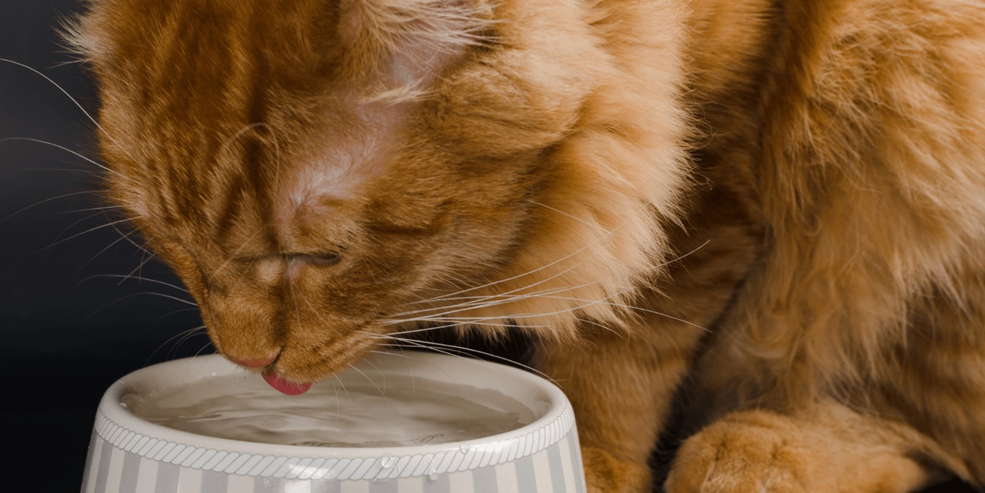Kidney Diseases in Cats

Lloyd Alexandria Chavez, R.M.T Cats possess a pair of kidneys located on either side of their abdomen, playing a crucial role in eliminating waste from their system. These organs are also key in regulating the balance of fluids, minerals, and electrolytes in the body, conserving water and protein, and supporting blood pressure and the production of red blood cells through the production of the hormone erythropoietin. Kidney disease in cats can manifest in several forms and can stem from various causes, typically classified into either acute or chronic categories. Acute kidney injury occurs when the kidneys are suddenly damaged, potentially impairing their function. This condition can affect both pets and humans and may result in diminished kidney performance. Fortunately, acute kidney injury can often be reversible, with approximately half of those affected—be they pets or humans—able to recover. The kidneys have a remarkable capacity for self-repair, provided the initial cause of injury is addressed and any exacerbating factors are eliminated. Recovery prospects depend on several factors, including the cause of the injury, its severity, whether other bodily systems are involved, the availability of treatments such as hemodialysis, and adherence to medical guidance.Chronic kidney disease (CKD), on the other hand, is frequently diagnosed in older cats and is characterized by a progressive decline in kidney function. Symptoms of CKD in cats include increased thirst and urination, reduced appetite, weight loss, vomiting, and a dull coat. CKD is an incurable condition that worsens over time, resulting from gradual kidney damage over months or years. Its progression and symptom onset are more gradual compared to acute kidney disease, which can emerge rapidly following significant kidney damage from causes such as infections or toxic substances like antifreeze or lilies. Cats with acute kidney disease typically exhibit severe symptoms swiftly. SYMPTOMS In the initial stages of chronic kidney disease (CKD), there may be no noticeable symptoms as the kidneys are still able to function adequately. However, as the disease progresses and the kidneys become increasingly impaired, symptoms will begin to manifest. These symptoms can develop gradually and may be subtle, making them difficult to detect. They include: DIAGNOSIS Chronic kidney disease is diagnosed through a series of blood and urine tests that measure levels of specific substances indicative of kidney function. These tests not only confirm the presence of kidney issues but also aid veterinarians in staging the disease, which helps in understanding its severity. The key laboratory tests include: Together, these tests provide a comprehensive assessment of kidney health, allowing for accurate diagnosis and staging of chronic kidney disease in cats. TREATMENT While it’s not possible to cure chronic kidney disease (CKD) or undo the damage that has occurred, steps can be taken to slow its progression and alleviate the symptoms. In cases where a cat is diagnosed with CKD and is showing signs of illness, the initial course of treatment may include: This treatment regimen aims to manage the symptoms and complications associated with CKD, improving the quality of life for cats living with this condition. Sources: https://www.pdsa.org.uk/pet-help-and-advice/pet-health-hub/conditions/chronic-kidney-disease-in-cats#:~:text=FAQs-,Overview,vomiting%2C%20and%20poor%20coat%20condition. https://www.petmd.com/cat/conditions/urinary/kidney-disease-cats https://www.ncbi.nlm.nih.gov/pmc/articles/PMC7379052/
Kidney Disease in Cats

Chavezlloyd Alexandria Baldago A cat has two kidneys, one on each side of the abdomen, and they play a vital role in filtering waste from the body. Additionally, the kidneys serve to regulate the body’s balance of fluids, minerals, and electrolytes. They conserve water and protein and play an important role in maintaining blood pressure and red blood cell production by making a hormone called erythropoietin. There are different types of kidney disease in cats and various underlying causes. These often develop into one of two categories: acute or chronic. Acute kidney injury is when the kidneys suddenly get damaged, which can sometimes make them work less effectively. It can happen in both small animals (like pets) and humans, and it might or might not lead to reduced kidney function. The good news is that acute kidney injury can often be turned around, with about half of the affected individuals, whether they are pets or people. The kidneys have a special ability to heal themselves if the problem that caused the injury is gone, and things that were making the injury worse stop. The chances of getting better depend on a few things, like what caused the kidney injury (if it can be fixed or not), how bad it is, if other parts of the body are affected, whether treatments like hemodialysis are available, and how well the person or pet follows the doctor’s advice. Chronic kidney disease, or CKD, is a common issue in older cats. It makes their kidneys work less effectively. Some signs of CKD in cats are drinking more water, peeing more, eating less, losing weight, throwing up, and having a rough coat. Unfortunately, there’s no cure for CKD, and it gets worse as time goes on. CKD results from damage to the kidneys that develops slowly over months and years and tends to cause symptoms which slowly progress. This is different from acute kidney disease, which develops if something suddenly causes a large amount of damage to the kidneys such as an infection or a poison such as antifreeze or lilies. Cats with acute kidney disease tend to develop serious symptoms very quickly SYMPTOMS Chronic kidney disease might not cause any symptoms in the early stages because the kidneys are still able to manage. Once the kidneys have been significantly damaged and are unable to cope, the symptoms will start to appear. Some can appear very slowly and can be hard to spot. Symptoms include: DIAGNOSIS Chronic kidney disease can be diagnosed using blood and urine tests. These tests detect raised levels of certain substances that may indicate the kidneys aren’t working properly. If necessary, these test results will also help the vet grade the cat’s kidney disease, which indicates how serious it is. Laboratory tests include: TREATMENT It’s not possible to cure chronic kidney disease or reverse the damage that has already been done, but it is possible to slow it down and reduce the symptoms. If your cat is poorly when they are diagnosed with chronic kidney disease, initial treatment might include: Sources: https://www.pdsa.org.uk/pet-help-and-advice/pet-health-hub/conditions/chronic-kidney-disease-in-cats#:~:text=FAQs-,Overview,vomiting%2C%20and%20poor%20coat%20condition.
Inflammatory Bowel Disease in Cats

Sushant Sadotra Feline inflammatory bowel disease (IBD) is a chronic condition that affects a cat’s gastrointestinal (GI) tract. The walls of the GI tract become thickened due to the infiltration of inflammatory cells, disrupting the cat’s ability to digest and absorb food properly. Although IBD can affect cats of any age, middle-aged and older cats are more prone to it. The exact cause of IBD remains unknown, but current evidence suggests that it may result from an abnormal interaction between the immune system, diet, bacterial populations in the intestines, and other environmental factors. Genetic abnormalities in the immune system are also believed to play a role in feline IBD, based on similarities to IBD in humans and dogs. Depending on the region of the GI tract and the type of inflammatory cells involved, IBD can manifest in different forms. If the stomach is inflamed, it is called gastritis; if the small intestine is inflamed, it is called enteritis, and if the colon is inflamed, it is called colitis. Lymphocytic plasmacytic enteritis is the most common form of IBD, where inflammatory lymphocytes and plasma cells attack the small intestine. Eosinophils, another type of inflammatory white blood cell, may also be involved in feline IBD, but are usually part of a mixed population of inflammatory cells. Neutrophilic IBD, which involves neutrophils, and granulomatous IBD, which involves macrophages, are two less common forms of IBD. In some cases, IBD can cause inflammation of other abdominal organs, such as the liver and pancreas. It is important to identify the type of IBD affecting a cat through appropriate diagnostic procedures to provide the best possible treatment and management. Clinical symptoms: Feline IBD is often characterized by a set of common clinical signs that include weight loss, vomiting, decreased appetite, diarrhea, lethargy, and bloody stools. The severity and frequency of these signs can vary depending on which parts of the gastrointestinal tract are inflamed. For instance, if the inflammation is situated in the stomach or higher regions of the small intestine, the cat may experience chronic vomiting. Conversely, inflammation in the colon is more likely to cause diarrhea, with or without blood in the stool. Diagnosis When it comes to making a diagnosis of feline IBD, it is important to conduct a thorough workup since many of the symptoms of IBD can overlap with other diseases. To determine the root cause of the symptoms, your veterinarian will most likely recommend conducting baseline blood work, fecal examinations, X-rays, or an abdominal ultrasound to check for metabolic disease, feline leukemia, parasitic or bacterial infections, hyperthyroidism, and certain types of cancer. Intestinal lymphoma, a form of cancer, can be particularly challenging to distinguish from IBD in cats. Additionally, a veterinarian may also measure the levels of B vitamins B12 and folate in the bloodstream, as IBD can hinder the absorption of these vitamins from the GI tract. Finally, a hypoallergenic food trial may be conducted to rule out food allergy as a possible cause. To further diagnose feline IBD, a biopsy is required to evaluate the tissue under a microscope. Increased numbers of inflammatory cells in the intestinal wall indicate the presence of IBD. Endoscopy and surgery are two methods of performing gastrointestinal biopsies, both of which require general anesthesia. However, surgery may be recommended for patients with suspected liver or pancreatic disease to biopsy these organs as well. Treatment If you suspect that your furry friend has intestinal parasites, it is important to consult with a veterinarian who will recommend appropriate treatment. The initial steps usually involve a combination of dietary changes and medications. Since there is no one-size-fits-all solution, your vet may need to experiment with different diet and medication combinations to determine the best therapy for your pet. Dietary Management If your cat is suffering from Inflammatory Bowel Disease (IBD), it is likely that dietary allergens are playing a role. Your veterinarian may suggest undergoing a food trial using hypoallergenic diets to help alleviate the symptoms. These diets include protein or carbohydrate sources that your cat has never consumed before. Some common initial choices are diets based on rabbit, duck, or venison. In case the symptoms do not improve with a hypoallergenic diet, your cat may benefit from diets that are high in fiber, low in fat, and easily digestible. It is important to note that it may take several weeks or even longer for your cat to show signs of improvement after a diet change. During any food trial, it is crucial to eliminate all other food sources, including table scraps, flavored medications, and treats. Medical Treatment Reference
Coomb’s test (EFB020)
Coomb’s test (EFB020) Coomb’s test Specimen type EDTA whole blood
Vitamin B12 (EFB026)
Vitamin B12 (EFB026) Vitamin B12 Specimen type Serum
Folic acid (EFB025)
Folic acid (EFB025) Folic acid Specimen type Serum
Feline blood typing (EFB019)
Feline blood typing (EFB019) Typing A, B, and AB Specimen type EDTA whole blood
Factor VII Deficiency (EFB018)
Factor VII Deficiency (EFB018) Factor VII Deficiency Specimen type EDTA whole blood
von Willebrand disease, vWD (EFB017)
von Willebrand disease, vWD (EFB017) von Willebrand disease, vWD Specimen type EDTA whole blood
D-dimer (EFB016)
D-dimer (EFB016) D-dimer Specimen type Sodium citrate plasma



